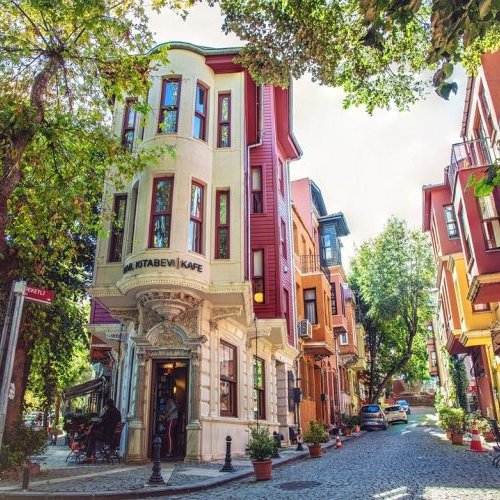(1) The Byzantine and Ottoman Relics
“Duration; about 8 hours”
- Hagia Sophia, was built in 537 on the order of the Roman Emperor Justinian, the most majestic monument of the Byzantine period, one of the symbols of Istanbul,
- Blue Mosque, was built on the order of Sultan Ahmet in 1617, the name owes to the colors of the 20,000 tiles built in Nicaea where the first Ecumenical Council was held,
- Hippodrome, built in lll. sec. by the Roman emperor Septimius Severus for horse racing, today it is a square where there are some ancient monuments.
- Topkapı Palace, built by Sultan Mehmet the Conqueror in 1478. For 4 centuries it was the government center of the Ottoman Empire,
- Basilica Cistern, one of the most evocative buildings of the Byzantine period, was built on the order of the Roman Emperor Justinian. It served as a water supply for centuries,
- Grand Bazaar, the largest and oldest covered market in the world, still active with 75 streets, 22 entrances and about 3000 shops that attracts millions of travelers every year and is also considered one of the first shopping centers in the world.
(2) Galata, Beyoglu, Taksim Square and Bosphorus Cruise
“Duration; about 8 hours”
- Bosphorus Cruise, the ride takes about 90 minutes to the second Bosphorus bridge. During the tour, it runs along both the Asian and European sides of the city,
- Galata Tower, built by the Genoese in 1348 as a surveillance tower,
- Main Residence of the Whirling Dervishes (to be visited from the garden), from the 15th century. Home of the whirling dervishes. Ground floor, today, is a museum and on the first floor every Sunday the show of the dervishes is organized,
- Otel Pera Palas, was built to accommodate passengers on the historic Orient Express train. Several famous personalities of the Orient Express have stayed there such as Agatha Christie, Ernest Hemingway, King Eduardo Vlll., Alfred Hitchcock, Jacqueline Kennedy Onassis, Zsa Zsa Gabor, Mata Hari and the first president of the Turkish Republic Ataturk,
- Catholic Church of Sant’Antonio, the largest Catholic place of worship in Istanbul built in Venetian neo-Gothic style, served by Italian priests. Mass is said in Polish, Turkish and English Italian,
- Avenue of Independence (Beyoglu), there are several particular and historical passages (galleries) on the Independence Avenue,
- Taksim Square, is the most symbolic square of all not only in Istanbul but in all of Turkey.
- Spice Bazaar, built in 1664 by Hatice Turhan Sultan, mother of Sultan Mehmet IV.,
(3) Three Districts; Fatih, (conservative) – Balat, (jewish)- Fener, (greek)
“Duration; about 8 hours”
- Zeyrek Mosque, originally built as the Church of Christ Pantocrator, converted into a mosque by the Ottomans. The mosque still retains some traces of the Byzantine period as a whole,
- Aqueduct of Valens, built by the Romans and fed the Roman cisterns bringing fresh water from the Belgrade Forest 23 km.,
- Quranic School of the Fatih Mosque, located in the complex of the Fatih Mosque. 220 students who study at the school then become imams after 8 years,
- Fatih Mosque, built after the conquest of Istanbul, one of the largest and most beautiful mosques in the city,
- Greek School in the Greek district of Fener, also known as the Red School, built in 19th century. It had 700 Greek allies. Still active in the Fener district, not accessible to the visitors, so the visit from outside.
- Greek Orthodox Patriarchate, before the Great Schism of the church in 1054, one of the five main seats of Christianity established since the first councils, from the council of Chalcedon in 451 the patriarchate of Constantinople. In hierarchical order it was the second after Rome, preceding Antioch, Alexandria and Jerusalem.
- Iron Church (San Stefano), built entirely of iron in the 19th century by the Bulgarian community on the land filled on the Golden Horn,
- Balat district, known as the Jewish quarter where the Jews of Istanbul settled from the 17th century,
- Church of San Salvatore in Chora, built as a church with the name of San Salvatore in Chora, converted into a mosque in 1511, nowadays famous as a museum of mosaics,
- City Walls of Constantinople, built at the behest of the Roman Emperor Theodosius in the 5th century. They still surround the old Constantinople for 21 km.
(4) Asian side of Istanbul: Uskudar, Kuzguncuk and Kadikoy
“Duration; about 8 hours”
- Mihrimah Mosque, forced in 1548 at the behest of Sultana Mihrimah, the only daughter of Sultan Suleiman,
- Kuzguncuk District, famous with its particular center and with the typical houses where television series are shot,
- Mother Sultana Mosque, built in 1710 by the mother of Sultan Ahmet lll, detail with the nests of birds on the walls of the mosque by the Ottomans
- Uskudar District Center, visit the Uskudar district center and market.
- Maiden Tower, built in the XI. sec. by the Byzantines to guard the entrance to the Bosphorus
- Center of the Kadikoy , visit the center and market of the Kadikoy and Moda district
- Spice Bazaar, built in 1664 to finance the expenses of Hatice Turhan Sultan Mosque, mother of Sultan Mehmet IV.





















RECENT COMMENTS